Roscommon is the county town and the largest town in County Roscommon in Ireland. It is roughly in the centre of Ireland, near the meeting of the N60, N61 and N63 roads.

Sheela na gigs are figurative carvings of naked women displaying an exaggerated vulva. They are architectural grotesques found throughout most of Europe on cathedrals, castles, and other buildings.
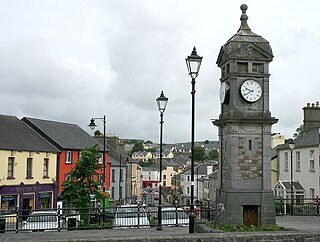
Boyle is a town in County Roscommon, Ireland. It is located at the foot of the Curlew Mountains near Lough Key in the north of the county. Carrowkeel Megalithic Cemetery, the Drumanone Dolmen and the lakes of Lough Arrow and Lough Gara are also close by. As of 2016, the population of the town was 2,568.
Knockcroghery is a village and townland in County Roscommon, Ireland. It is located on the N61 road between Athlone and Roscommon town, near Lough Ree on the River Shannon. The townland of Knockcroghery is in the civil parish of Killinvoy and the historical barony of Athlone North.

Gloucester House or Gloucester Lodge is a former royal residence on the esplanade in the seaside resort of Weymouth on the south coast of England. It was the summer residence of Prince William Henry, Duke of Gloucester and Edinburgh (1743–1805), fourth son of Frederick, Prince of Wales, and brother of King George III. During his recovery from porphyria in 1789, George III spent some time convalescing there. The king occupied the right-hand part of the building, and had use of the garden, where the later, left wing stands. His doctors encouraged him to visit the resort to benefit from the sea air and salt water. The patronage of the king was important in drawing fashionable society to the south coast town.
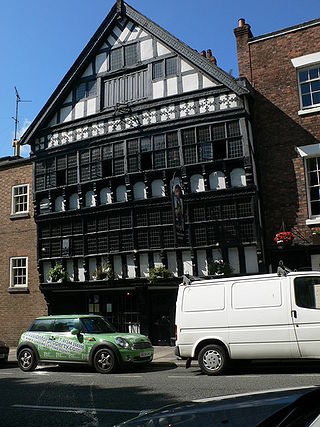
The Bear and Billet is a public house at 94 Lower Bridge Street, Chester, Cheshire, England. It is recorded in the National Heritage List for England as a designated Grade I listed building. The building has been described as "the finest 17th-century timber-framed town house in Chester" and "one of the last of the great timber-framed town houses in England". It stands on the west side of Lower Bridge Street to the north of the Bridgegate.

Tinnakill Castle, also known as Tynekill, is a ruined medieval tower house in the parish of Coolbanagher, in the Barony of Portnahinch, County Laois in Ireland.
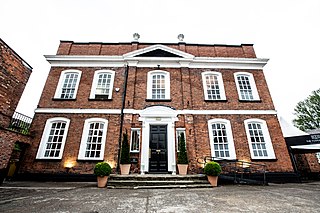
9 Mill Street is a Georgian house in Nantwich, Cheshire, England. The present building dates from around 1736 and is a grade II* listed building. Nikolaus Pevsner calls it a "fine, spacious" house, and the English Heritage listing describes it as a "substantial and well-detailed early, C18 Town House, which ... retains much original interior fabric." Formerly a town house, bank and political club, it is currently a restaurant and bar.

The L. Richardson Preyer Federal Building is a courthouse of the United States District Court for the Middle District of North Carolina in Greensboro, Guilford County, North Carolina. It was completed in 1933, and was renamed in honor of United States Representative and District Court judge L. Richardson Preyer in 1988. It is located at 324 West Market Street.

Drumcar House is a manor house in the historical parish of Drumcar in the barony of Ardee, 1 mile (1.6 km) northeast of Dunleer, County Louth, Leinster, Ireland. The house was built in 1777. It was home to the McClintock family from then to the 1940s, stemming from Alexander McClintock (1692–1775). One of its best known owners was John McClintock (1770–1855), a magistrate for County Louth, and formerly Serjeant at Arms in the Irish House of Commons, who was known to be occupying the estate in 1805 and until his death. The house was sold in about 1903 by The 2nd Baron Rathdonnell to his cousin, Frank McClintock (1853–1924), Rector of Drumcar and Dean of Armagh.
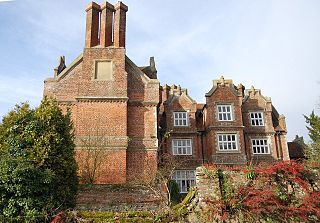
Hollingbourne Manor is an Elizabethan manor house in Hollingbourne, Kent, England.
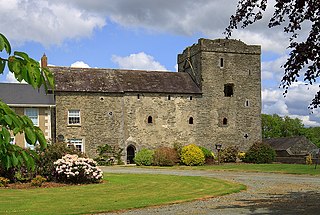
Athclare Castle is a Tudor tower house in the Dunleer area of County Louth in Ireland. Built in the 1550s, Athclare was built for the Barnewell family, and is typical of defensive architectural structures built in the Pale during the Tudor period in Ireland. Athclare has been extended and adapted in the centuries since its construction and is classified as a site of National social historical importance by the Irish National Inventory of Architectural Heritage.

Lonsdale House is a heritage-listed detached house at 283 Boundary Street, Spring Hill, City of Brisbane, Queensland, Australia. It was built from 1860s circa to 1950s circa. It was added to the Queensland Heritage Register on 27 August 1999.

Roscommon County Museum is a museum dedicated to the history of County Roscommon, and is run by the County Roscommon Historical and Archaeological Society. The museum is housed in a former Presbyterian church in Roscommon town.
Woodhouse is a Georgian mansion and c. 500-acre estate just outside the village of Stradbally, County Waterford, Ireland.

Liberty Hall is a heritage-listed detached house at 84 Limestone Street, Ipswich, City of Ipswich, Queensland, Australia. It was built c. 1857. It is also known as Mary Tregear Hostel. It was added to the Queensland Heritage Register on 21 October 1992.

Taghmon Church is a fortified church and National Monument in County Westmeath, Ireland.

Hawkswood is a townland in the civil parish of Kinawley, barony of Tullyhaw, County Cavan, Ireland. The original Irish place name was Cluain Caomh meaning 'The Beautiful Meadow'. The town of Swanlinbar is partially situated in Hawkswood. According to the 1938 Dúchas collection two sub-divisions are- The Cleity - A name given to a field in a farm owned by Mr. Patrick Maguire, Hawkswood, Swanlinbar, Co. Cavan. The Rhythars - a name given to a field in a farm owned by Mr Hugh McBrien, Hawkswood, Swanlinbar.
Turvey House was a substantially altered 16th-century house, with tower house elements, synonymous with the townland of Turvey near Donabate in North County Dublin. Turvey is said to be a reference to the Irish mythical character Tuirbe Tragmar, father of Gobán Saor. At various stages, the house and surrounding lands formed the family seat of the Barnewall family. The house is said to have been constructed with stone from the ruins of the nearby Grace Dieu Abbey by either Sir Christopher Barnewall or Sir Patrick Barnewall.

Grimethorpe Hall is a manor house in Grimethorpe, South Yorkshire, England. Built circa 1670 for Robert Seaton, it is thought to be in the style of York architect Robert Trollope. Around 1800 the hall passed to John Farrar Crookes of Tunbridge Wells. It was last used as a house in the 1960s and afterwards was purchased by the National Coal Board. The National Coal Board applied to demolish it in 1981 but, after a campaign by the Ancient Monuments Society, this was unsuccessful. The structure received statutory protection as a grade II* listed building in 1985.

















